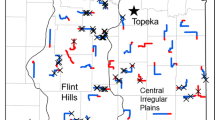Abstract
Ground-nesting North American landbirds have declined in the longterm, including species with a variety of migratory strategies. The mesopredator release hypothesis explains declines by suggesting that the virtual elimination of top carnivores (large-bodied canids and felids) from much of North America has “released” populations of nest-destroying mesopredators (i.e., medium-sized terrestrial omnivores such as the raccoon Procyon lotor). The hypothesis predicts (1) higher nest success in the presence than in the absence of top carnivores, and (2) a positive relationship between mesopredator abundance and nest predation. Results from a 4-year "natural experiment" in the agricultural landscape of southern Michigan tended to support prediction 1. When coyotes (Canis latrans) were absent in 1993 and present in 1994, 1995 and 1996, Mayfield nest survival in song sparrows (Melospiza melodia), a ground-nesting landbird, increased significantly during the same 4-year interval. Relative frequency of nest predation, the most common cause of nest failure, declined significantly over the four years. Coyotes may have decreased nest predation in 1994–1996 by reducing the abundance of raccoons, apparently the main nest predator in the study area. In an experiment testing prediction 2, mesopredator abundance and predation rate on artificial nests were positively related, as predicted by the hypothesis. Although the present study is not wholly conclusive by itself, we cautiously suggest it contributes to a growing body of evidence derived from a number of studies supporting the mesopredator release hypothesis.
Similar content being viewed by others
Author information
Authors and Affiliations
Additional information
Received: 23 May 1997 / Accepted: 12 January 1998
Rights and permissions
About this article
Cite this article
Rogers, C., Caro, M. Song sparrows, top carnivores and nest predation: a test of the mesopredator release hypothesis. Oecologia 116, 227–233 (1998). https://doi.org/10.1007/s004420050583
Issue Date:
DOI: https://doi.org/10.1007/s004420050583




